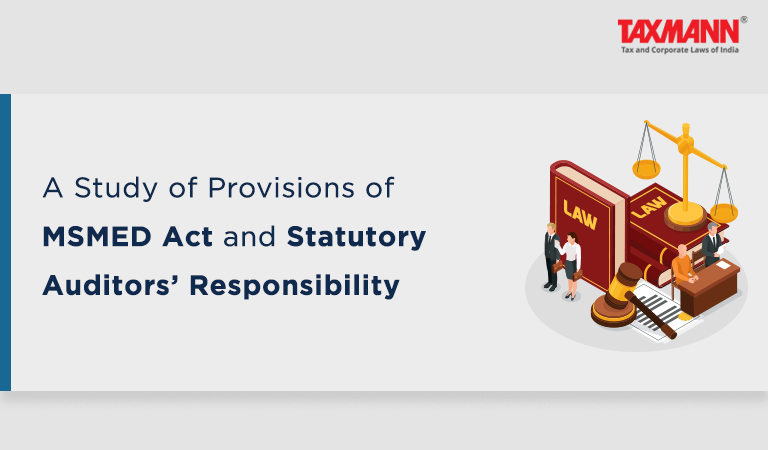A Study of Provisions of MSMED Act and Statutory Auditors’ Responsibility
- Blog|News|Account & Audit|
- 2 Min Read
- By Taxmann
- |
- Last Updated on 28 February, 2023
Considering the importance of MSMEs (Micro Small and Medium Enterprises) for the entire economy, which contribute close to 35% to India’s GDP, the government always tries to incentivize them. One such very important incentive for MICRO and SMALL Enterprises is, regulating their CREDIT PERIOD, which is governed by MSMED Act 2006. The regulated credit period of 45 days for all purchases made from MICRO and SMALL units has casted big responsibility on the Auditors as well. The following paper is about the Duties and Responsibilities of Auditors and the audit procedure to be followed by them.
I. Can any Entity be called an MSME?
No, only the entity that has obtained Udyam Registration (online self-declaration based registration – www.udyamregistration.gov.in) is said to be MSME. Further, the Enterprise has been divided into 3 categories called as Micro, Small and Medium.
II. Liability of buyer to make payment
Where any supplier supplies any goods or renders any services to any buyer, the buyer shall make payment therefore on or before the date agreed upon between him and the supplier in writing or, where there is no agreement in this behalf, before the appointed day. Provided that in no case the period agreed upon between the supplier and the buyer in writing shall exceed forty-five days from the day of acceptance or the day of deemed acceptance.
III. Credit period advantage
Sec 15 states that buyer shall make payment to MSEs (Only MICRO and SMALL Enterprises) who have Udyam Registration within 45 Days of acceptance/deemed acceptance. While sec 16 states that if buyer fails to make payment to the registered entity within 45 days, he is liable to pay interest at thrice the bank rate as notified by the RBI.
IV. Auditors’ Responsibility under the Companies Act 2013
(a) To check whether the Company is a Specified Company
(b) Filing of MSME-1 return
(c) Disclosure in Notes to accounts
(d) Audit Procedure – Understand the process to identify MSE suppliers, yearly correspondence, MSME (Udyam) RC, outstanding dues and delayed dues to Micro & Small Enterprises, interest due on delayed payments, any claim/legal notice is received from any of the suppliers.
(e) Audit conclusion on findings & Reporting of non-compliance
(f) Management Representation Letter (MRL) for identified/not identified MSEs.
Click Here To Read The Full Story
Disclaimer: The content/information published on the website is only for general information of the user and shall not be construed as legal advice. While the Taxmann has exercised reasonable efforts to ensure the veracity of information/content published, Taxmann shall be under no liability in any manner whatsoever for incorrect information, if any.

Taxmann Publications has a dedicated in-house Research & Editorial Team. This team consists of a team of Chartered Accountants, Company Secretaries, and Lawyers. This team works under the guidance and supervision of editor-in-chief Mr Rakesh Bhargava.
The Research and Editorial Team is responsible for developing reliable and accurate content for the readers. The team follows the six-sigma approach to achieve the benchmark of zero error in its publications and research platforms. The team ensures that the following publication guidelines are thoroughly followed while developing the content:
- The statutory material is obtained only from the authorized and reliable sources
- All the latest developments in the judicial and legislative fields are covered
- Prepare the analytical write-ups on current, controversial, and important issues to help the readers to understand the concept and its implications
- Every content published by Taxmann is complete, accurate and lucid
- All evidence-based statements are supported with proper reference to Section, Circular No., Notification No. or citations
- The golden rules of grammar, style and consistency are thoroughly followed
- Font and size that’s easy to read and remain consistent across all imprint and digital publications are applied








 CA | CS | CMA
CA | CS | CMA


